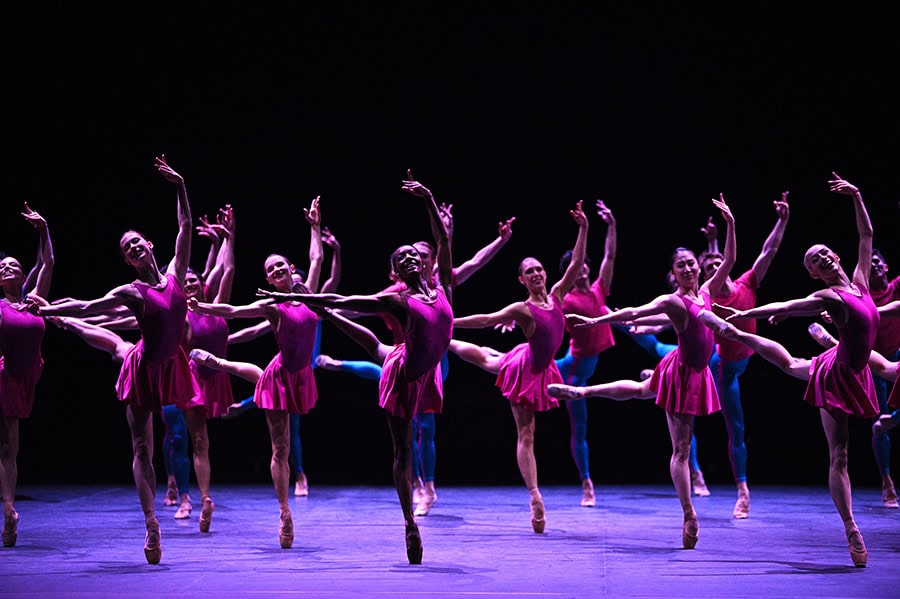English National Ballet’s William Forsythe Evening
Posted: May 4th, 2022 | Author: Nicholas Minns | Filed under: Performance | Tags: Amy Raymond, Ayman Harper, Brooklyn Mack, ENB, English National Ballet, James Blake, Lex Ishimoto, Noah Gelber, Roman Mejia, Stefanie Arndt, Tamara Rojo, Tyler Peck, William Forsythe | Comments Off on English National Ballet’s William Forsythe EveningEnglish National Ballet, The Forsythe Evening, Sadler’s Wells, March 31, 2022

Last year during lockdown, over Zoom, William Forsythe choreographed The Barre Project (Blake Works II) on a quartet of dancers in New York: Tyler Peck, Lex Ishimoto, Brooklyn Mack and Roman Mejia. “Ballet is a great platform for compositional thinking,” he remarked at the time. “It’s a way of hearing, and so what you’re basically demonstrating is how you listen.” The Barre Project revealed a choreographer whose legendary familiarity with classical ballet technique allows him to take it in directions that ring true to its source while extrapolating its technical and spatial possibilities, just as Balanchine had done at New York City Ballet. In his way of working and in the choreography itself, Forsythe demonstrated the excitement of a precocious, hyper-active child at play: creating not to indulge an inherent aesthetic sensibility so much as to respond instinctually to James Blake’s music within given physical parameters. If anyone stood out it was Peck, but all four were clearly inspired by what Forsythe had brought out of them; in order to make sense of the choreography, they performed with the same excitement and impulsion that Forsythe brought to the work.
For English National Ballet (ENB)’s recent The Forsythe Evening at Sadler’s Wells, both works on the program — Blake Works I and Playlist (EP) — are conceived with a broader brush than The Barre Project (Blake Works II) — more orchestral than chamber — and neither was fully conceived and choreographed on the company. Blake Works I, to seven tracks from James Blake’s album The Colour in Anything, was first created on the Paris Opera Ballet in 2016 and has been staged for ENB by Stefanie Arndt and Ayman Harper, while Playlist (EP), to the beats of neo-soul and house music, and staged for ENB by Amy Raymond and Noah Gelber, is an enhanced version of Playlist (Track 1,2) that Forsythe had set on the male dancers of ENB in 2018 and subsequently extended for Boston Ballet a year later. There is always going to be an inherent challenge in passing on a choreographer’s initial motivation to dancers on whom the choreography was not conceived, especially to dancers who are not familiar with his way of working. In an interview in the program with Sarah Crompton, Forsythe describes these two abstract works as dancing for the pure pleasure of dancing, a ‘celebration’.
But there’s a subtle disconnect between the celebratory feeling of the choreography and the performance of the choreography by the dancers: their celebration — with one or two exceptions — seems to get lost in the satisfaction of accomplishing the steps. If choreography is a way of hearing, ENB’s dancers are hearing something different not only from each other but from what the choreography is manifestly singing. At the final bows, Forsythe improvised a brief impromptu boogie by way of instigating the encore; there was so much celebration in his movement that it came across as pure spirit in a musical body, and it stood out from the rest of the evening because it revealed the very ingredient that had been lacking.
This is one of the last programs, if not the last, ENB will be dancing before artistic director, Tamara Rojo, leaves for San Francisco Ballet along with some of her current dancers. Rojo has done so much for the company’s reputation in terms of getting works by choreographers like Pina Bausch, Jiri Kylian, Mats Ek and Forsythe, getting Akram Khan to choreograph a Giselle, pulling together a program by female choreographers and most recently reviving Raymonda. Not to mention attracting the sponsorship for and overseeing the move to their new home at the Mulryan Centre for Dance. This is the kind of artistic acuity that has reframed ENB’s image, and if there is a rivalry between ENB and Rojo’s former company, the Royal Ballet, it is not hard to see that the former has constantly outclassed the latter in its string of achievements. In all areas, perhaps, but one: the multiple publicity triumphs Rojo has accomplished seem to have overshadowed the company’s dancers. While technique is still at a high level — there is nothing wrong with the technical ability of the company under its swathe of ballet masters — there are traces of cloud hanging over the company. The news of Rojo’s departure may be recent, but the cloud — despite a counterpart of sunny spells — has been part of the climate for some time.
Even after the performance of The Forsythe Evening has finished and the memory allowed to settle, there is not much left of the evening apart from the knowledge of having seen Forsythe’s work in the absence of its full realization.